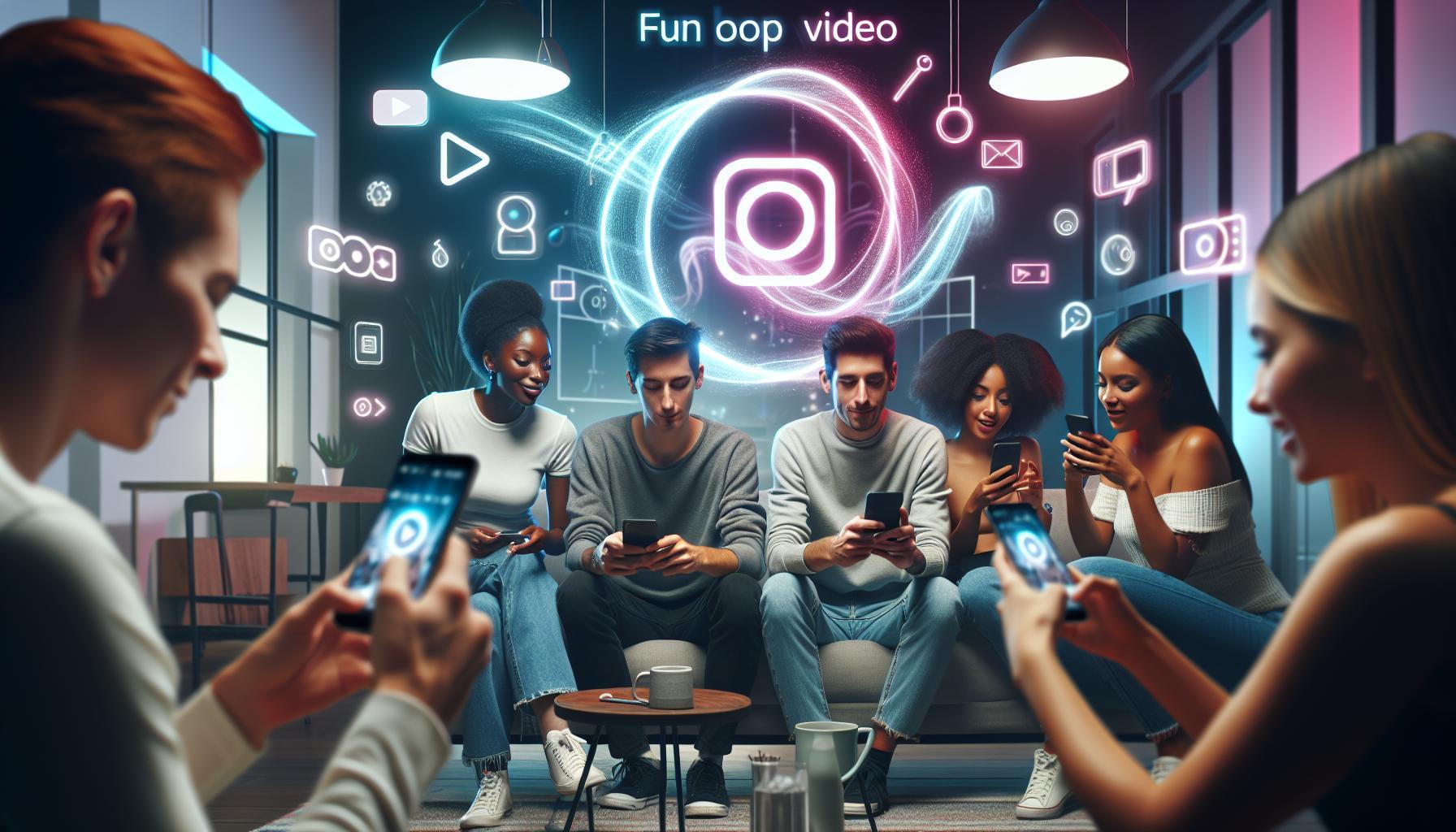Did you know that Instagram Stories, which disappear after 24 hours, have become a popular way to share fleeting moments? However, many users wonder about privacy issues, particularly whether someone can know if you screenshot their Story. Understanding this aspect is essential for maintaining privacy while engaging on the platform.
As you navigate Instagram, the fear of being watched or judged can be daunting, especially when sharing personal moments. Knowing the limits of privacy and what others can see fosters more confident sharing. This article will delve into the mechanics behind Instagram’s features, demystifying screenshot notifications and providing insights to safeguard your digital presence. Stay with us to uncover how to protect your privacy while connecting meaningfully with friends.
Understanding Instagram Story Screenshots and Privacy
In today’s digital landscape, where sharing moments is as easy as a few taps, understanding the implications of taking screenshots, especially of Instagram Stories, is crucial for maintaining your privacy. Instagram Stories are designed to be ephemeral, disappearing after 24 hours, but what if someone captures your moment by taking a screenshot? This concerns many users who want to share candid content without the fear of it being stored permanently by others. While Instagram initially introduced a notification system to alert users when someone screenshots their story, this feature has seen changes that can leave you questioning what happens when that button is pressed.
When you take a screenshot of an Instagram Story, it’s important to note that Instagram no longer notifies the user about the screenshot. This change can cause some users to feel a false sense of security when sharing stories, believing that privacy settings will shield their content from unwanted views. The ephemeral nature of Stories can create islands of vulnerability where users might think their content will vanish without a trace, but in reality, anyone could still save or share those moments through screenshots or third-party apps. Increasing awareness around these actions helps users navigate their content more wisely.
To protect your privacy effectively, it’s vital to take a proactive stance. Here are some key strategies to consider:
- Adjust Your Audience: Use the “Close Friends” feature to limit who can view your stories. This allows for more control over who sees your content.
- Learn Your Settings: Familiarize yourself with Instagram’s privacy settings. Make your account private and review follower requests regularly.
- Think Before You Share: Carefully consider the content you post. If it’s sensitive, perhaps it’s best to skip sharing it altogether.
With the evolving digital space, it’s essential for users to stay informed about their privacy options and understand the nuances of sharing on platforms like Instagram. By embracing these practices, you not only enhance your privacy but also empower yourself and your audience to engage meaningfully while respecting the boundaries that come with sharing personal moments.
How Instagram Notifies Users About Screenshots

In the ever-evolving world of social media, understanding how Instagram handles screenshot notifications is crucial for users who wish to protect their content. Users often share brief glimpses into their lives through Instagram Stories, expecting these posts to disappear within 24 hours. This temporary nature offers a sense of security; however, the reality of screenshots can alter that perception significantly. While Instagram was once known for notifying users whenever someone took a screenshot of their story, this feature has been discontinued, leading to many misconceptions about privacy on the platform.
Currently, if a user captures a screenshot of your Instagram Story, you will not receive a notification about it. This fundamental shift can create a false sense of safety, encouraging users to share more candid or sensitive content without realizing the potential for that moment to be permanently saved or shared by others. To further complicate matters, general awareness of this change isn’t as widely spread as it should be, leaving many individuals in the dark about who might be saving their shared moments. The absence of notifications doesn’t mean your content is out of reach; anyone can easily take a screenshot, leaving your fleeting memories vulnerable.
To navigate this landscape effectively, it’s essential to prioritize your audience and understand the platform’s privacy settings. Here are some recommended practices to enhance your experience and maintain control over your stories:
- Utilize “Close Friends”: This feature allows you to share your Stories exclusively with a selected group, ensuring that only those you trust can view them.
- Keep Your Profile Private: Switch your account to private to limit who can see your posts and Stories, providing an extra layer of security.
- Be Mindful of Content: Before posting sensitive information or images, take a moment to consider the potential consequences of anyone being able to screenshot and share your content.
By adopting these strategies, you can create a more controlled and safe experience on Instagram while still enjoying the spontaneity and engagement that Stories provide. Recognizing the nuances of these features empowers users to make informed choices about their content and privacy.
The Truth Behind Screenshot Notifications

The world of Instagram Stories is both vibrant and fleeting, offering users a unique way to share their lives, yet allowing for potential privacy pitfalls. A common misconception among users is that taking a screenshot of a Story will send a notification to the original poster. However, Instagram discontinued this feature back in 2018, meaning that if someone captures your Story, you will remain blissfully unaware. This change has led to a significant misunderstanding of privacy protocols on the platform. Many users may feel emboldened to share more intimate or candid moments under the false assumption that their content will only be viewed temporarily.
Understanding this shift is crucial, especially for content creators, influencers, and everyday users. Consider the implications: when a Story is shared with followers, it could be saved and shared indefinitely, without the original user’s consent or knowledge. To navigate this landscape effectively, users should reconsider what they’re posting in their Stories and whom they are sharing with. Are you sharing something that could be taken out of context? When you tap “Share” on a moving moment, it might be worth weighing the potential for that moment to be preserved beyond its intended lifespan.
To bolster your privacy and maintain control over your shared content, consider employing several strategic practices. Utilize the “Close Friends” feature, which allows you to curate a list of people with whom you feel comfortable sharing more personal Stories. This small but powerful adjustment can help mitigate concerns over who has access to your moments. Additionally, switching your account to private can further shield your content, limiting visibility to only approved followers. Lastly, always be mindful of the content you post-ask yourself if the image or moment is worth the risk of it being preserved in someone else’s device.
By actively engaging with these privacy measures, users can confidently share their experiences while minimizing the chance of unwanted duplication or distribution of their Stories. Understanding the current landscape of Instagram’s features helps users make informed decisions, ensuring their engagement remains both fulfilling and secure.
Privacy Settings You Should Know About
In the realm of Instagram, where sharing personal moments is just a tap away, understanding the platform’s privacy settings is crucial for every user. With the potential for your ephemeral Stories to be saved and reused by others, being proactive about your privacy is essential. Fortunately, Instagram provides a range of privacy features that empower you to control who sees your content, enhancing your overall experience on the platform.
One of the most effective ways to manage your audience is by leveraging the Close Friends feature. This allows you to create a personalized list of followers who can view your more private Stories. By curating this list, you can share life’s candid moments with a select group without the worry of them being broadcast to all your followers. To use this feature, simply tap on your profile icon at the bottom right, then select “Close Friends” from the menu. Add users by tapping the Add button next to their names. This way, you maintain a level of intimacy and assurance over who is privy to your more personal insights.
Another critical action to enhance your privacy is to convert your account to Private. In this mode, only users you approve can follow you and see your Stories, offering a significant layer of security. To switch to a private account, navigate to your profile, tap on the three horizontal lines in the top right corner, go to Settings, and select Privacy. From there, toggle the Private Account option. This will restrict access to your content and help you manage who engages with your Stories.
Additionally, be proactive about regularly reviewing your followers and removing anyone who no longer aligns with your desired audience. If you ever feel uncomfortable with a follower seeing your moments, it’s completely acceptable to remove them. To do this, visit your profile, tap on your follower count, locate the user you’d like to remove, and tap the Remove button next to their name.
By harnessing these privacy settings and creating a trusted space, you can confidently share your life on Instagram while minimizing the risk of your Stories being captured without your permission. Remember, when it comes to your digital content, it’s better to be safe than sorry.
What Happens When You Take a Screenshot
When you decide to capture an Instagram Story by taking a screenshot, it’s important to understand the implications of that action in terms of privacy and user experience. Specifically, Instagram does not notify users when someone takes a screenshot of their Stories. This distinction is crucial for anyone sharing personal or sensitive content on the platform, as it provides a level of anonymity to those wishing to save or refer back to a Story without alerting the creator. For many users, this functionality underlines the need for caution and awareness of what they share.
However, while Instagram does not currently notify users about screenshots of Stories, it does have systems in place that address captured content in other areas, such as direct messages or disappearing photos. Understanding this distinction can help you navigate your own privacy settings effectively. For example, if you’re sharing something particularly private or sensitive in your Stories, it’s wise to consider using the Close Friends feature, ensuring that only select individuals can view your content. This small adjustment can drastically decrease the likelihood of unwanted captures.
To utilize Instagram effectively while maintaining a level of comfort with your privacy, it is also beneficial to familiarize yourself with the overall engagement culture on the platform. Many users frequently view Stories, and the dynamic nature of ephemeral content can lead to spontaneous, sometimes regrettable, decisions about sharing. Being strategic about what you post can minimize the risk of your content being captured without your consent. If you’re ever unsure, leaning towards sharing less personal content can offer peace of mind.
In conclusion, while the absence of notification for screenshots might seem liberating, it reinforces the imperative for users to take charge of their shared content. This means considering what to share, who is in your audience, and leveraging Instagram’s privacy features to protect yourself while enjoying the social engagement that the platform offers. By cultivating an acute awareness of your digital footprint, you can navigate Instagram with confidence and a clearer understanding of your privacy landscape.
Myths vs. Facts: Screenshot Notifications
In the realm of social media, misconceptions about privacy features can often lead to anxiety and confusion, especially when it comes to the seemingly ephemeral nature of Instagram Stories. There’s a pervasive myth that when you take a screenshot of someone’s Story, the creator is immediately alerted. This belief can discourage users from freely sharing their content, under the impression that their privacy is constantly under threat. However, the truth is far less alarming: Instagram does not notify users when someone takes a screenshot of their Story. This fundamental understanding is crucial for both casual users and marketers navigating the platform.
Many users may feel uncomfortable sharing personal stories due to the fear of being unknowingly captured and stored by others. To demystify this concern, let’s consider a few critical points:
- Fact: Instagram only notifies users about screenshots in direct messages and disappearing photos. If you send a disappearing photo via DM and someone takes a screenshot, you will indeed be notified.
- Myth: All content shared on Instagram triggers a notification when captured. This is not the case; only specific types of content prompt alerts.
- Fact: Users maintain control over their audience by adjusting privacy settings. By using features such as “Close Friends,” you can restrict who sees your Stories, which can significantly reduce the anxiety around potential screenshots.
Understanding these nuances not only empowers users to share more freely but helps build a significant degree of trust in the platform’s structures. For content creators, this knowledge can inform strategic decisions about engagement-creating more authentic connections with followers, knowing that their content remains private unless explicitly shared. Additionally, being mindful of the context in which you share your Stories is crucial; if the intent is to convey a message that requires confidentiality, the Close Friends feature can be a simple yet effective solution.
Ultimately, being aware of the myths surrounding screenshot notifications can enable users to navigate Instagram more confidently. Emphasizing and educating oneself about the platform’s privacy features allows for a healthier engagement with the content being shared-whether it’s a standout moment from your day or a marketing campaign aimed at building brand loyalty. As you share more stories without fear, remember that protecting your content is entirely within your hands.
How to Manage Your Privacy on Instagram
In the rapidly evolving landscape of social media, managing your privacy on Instagram is crucial for enjoying a safe and secure experience. With the increasing emphasis on personal data protection, being proactive about how you share your content, especially through Stories, is necessary to safeguard your privacy. Start by familiarizing yourself with Instagram’s robust privacy settings, which empower you to control who sees your content and how they interact with your profile.
To optimize your privacy, ensure your account settings are aligned with your preferences. Navigate to your profile, tap the three lines in the top right corner, and select “Settings.” From there, explore the options under “Privacy.” You have the choice to switch your account to private, which means only users you approve can see your posts and Stories. This is a fundamental step in protecting your content from unwanted viewers. Additionally, consider using the “Close Friends” feature when sharing Stories-it allows you to select a specific group of followers to view your content, ensuring that your more personal moments stay within a trusted circle.
It’s also helpful to regularly review your followers and remove anyone who doesn’t align with your desired audience. You can do this by going to your followers list, tapping on “Remove” next to any user you wish to disconnect from. This practice minimizes the risk of unwanted engagement or potential screenshots from viewers you may not fully trust. Furthermore, be mindful of the content you share; avoid posting sensitive or easily screenshot-able information. Instead, think strategically about how you can generate engaging content while maintaining a level of privacy that feels comfortable for you.
Lastly, stay informed about Instagram’s updates regarding privacy features. The platform is continually evolving, and features that enhance your privacy are often introduced. Following Instagram’s official blog or social media channels will keep you updated on new tools and settings that can further protect your Stories and overall experience. By taking these steps, you create a more secure Instagram environment while confidently sharing the moments that matter most to you.
Tips for Protecting Your Stories from Viewers
In today’s digital landscape, where sharing moments through Instagram Stories is a common practice, ensuring your privacy is more important than ever. Despite the transient nature of Instagram Stories, awareness about who can view and potentially screenshot your content is crucial. While Instagram does not notify users when their Stories are screenshotted, this doesn’t mean your content is safe from being saved or shared.
To enhance the privacy of your Stories, start by utilizing Instagram’s “Close Friends” feature. This allows you to create a curated group of trusted followers who can view specific Stories, isolating your more personal content from your broader audience. To set this up, navigate to your profile, tap the three lines in the top right corner, select “Close Friends,” and add the users you wish to include. Whenever you create a Story, simply choose the “Close Friends” option to share it only with that select group.
Additionally, consider switching your account to private. When your account is private, only users you’ve approved can see your Stories. To make this change, head to “Settings,” tap “Privacy,” and toggle the “Private Account” option. This fundamental step not only helps protect your content from unwanted viewers but also minimizes the chances of screenshotting by unfamiliar users.
It’s important to regularly review your follower list and remove anyone who doesn’t fit your desired audience. Navigate to your followers list, tap on the “Remove” option next to users you wish to disconnect from. This proactive approach helps eliminate potential privacy issues and ensures that only those you trust can view your Stories. Finally, always be mindful of the content you post; avoid sharing sensitive information that could be misused if screenshotted.
By employing these strategies, you can significantly enhance your privacy on Instagram Stories, allowing you to share your moments with confidence. Remember, while the platform gives you tools to protect your content, your awareness and actions play a critical role in maintaining your privacy.
Best Practices for Sharing Stories Privately
In an age where privacy concerns are mounting, particularly on platforms like Instagram, knowing how to share your Stories confidentially is essential. Stories are meant to be ephemeral, but the reality is that the potential for screenshots can undermine the temporary nature of your content. By implementing a few best practices, you can significantly enhance your control over your shared moments and safeguard your privacy.
One of the most effective strategies is to leverage Instagram’s “Close Friends” feature. By creating a tight-knit group of trusted followers, you can selectively share Stories that you wouldn’t want a wider audience to access. To set up your Close Friends list, navigate to your profile, tap the three horizontal lines in the top-right corner, and select “Close Friends.” Here, you can add users who you trust. When posting a Story, simply choose the “Close Friends” option, ensuring your more personal moments are shared only with those you deem suitable.
Another crucial step is to switch your account to private. A private account restricts your followers to only those you have personally approved, greatly reducing the risk of unwanted viewers and potential screenshotting. To activate this feature, go to “Settings,” tap “Privacy,” and toggle the “Private Account” option. Regularly reviewing your followership is essential; remove individuals who no longer align with your sharing preferences by navigating to your “Followers” list and tapping “Remove” next to any user you wish to disconnect from. This routine helps maintain a safe community around your stories.
Finally, always be discerning about the type of content you choose to share. Avoid posting sensitive or personal information that could be misused if screenshotted. It’s advisable to think twice before sharing anything you wouldn’t want publicly available. By combining these practices-using the Close Friends feature, maintaining a private account, and being cautious with content-you create a robust strategy for sharing your Stories securely and confidently, ensuring that your digital footprints are minimal while enjoying the benefits of social connectivity.
Exploring Alternatives to Instagram Stories
In a world where privacy is becoming increasingly precious, users are actively seeking ways to share content without the fear of unwanted visibility. While Instagram Stories provide a quick way to engage with followers, their ephemeral nature can raise concerns around screenshots and long-term digital footprints. Fortunately, several alternatives to Instagram Stories can help you maintain control over your content while still allowing for meaningful connections.
One alternative worth exploring is Facebook Stories. As an integrated option for existing Facebook users, this platform allows you to share moments that disappear after 24 hours, similar to Instagram. The advantage of Facebook Stories lies in its audience control; since you can tailor who sees your stories by tweaking privacy settings, it’s easier to create a safe sharing environment.
Another excellent option is Snapchat, a platform built entirely around ephemeral content. With Snapchat, users are notified if someone takes a screenshot of their snaps, reinforcing a culture of privacy awareness. Plus, the platform’s dynamic filters and interactive lenses add creativity to your storytelling, making it a fun alternative for users looking for different ways to express themselves.
If your focus is on managing engagement while prioritizing privacy, consider Pinterest Stories or using Instagram Highlights. With Highlights, you can choose specific Stories to keep on your profile permanently, allowing you to curate an ongoing narrative while maintaining control over visibility. This feature is particularly useful for brands and content creators who want to showcase their best work without continually posting new content.
For those particularly concerned about privacy, private messaging apps like WhatsApp or Telegram allow for more controlled sharing of images and videos. You can send temporary images that disappear after viewing, thus reducing the chances of screenshots. These platforms cater to a more intimate audience, allowing you to maintain deeper relationships without broadcasting to a broader public.
In short, whether you opt for other social media platforms or rely on private messaging, a variety of alternatives can enhance your storytelling while mitigating privacy risks. Exploring these options not only empowers you as a user but also reflects the evolving landscape of social media, where privacy and sharing can coexist harmoniously.
Keeping Your Engagement High While Protecting Privacy
In the dynamic world of social media, maintaining high engagement on your Instagram Stories while safeguarding your privacy is not just a challenge; it’s a strategic necessity. With the ephemeral nature of Instagram Stories, users often grapple with the fear of unwanted viewers or screenshotting, but there are effective ways to maximize interaction without compromising your privacy.
To enhance your engagement while controlling visibility, utilize the Close Friends feature. This allows you to share Stories exclusively with a selected group, ensuring that only trusted followers can view your content. To set this up, navigate to your profile, tap on the menu icon, select Close Friends, and add users you wish to include. By doing so, your Stories can be more personal, and you can foster deeper connections with your audience, as they’ll feel more special being part of a select group. Plus, engaging with a smaller audience can lead to higher interaction rates, as these viewers are likely more invested in your content.
Moreover, consider the strategic use of Story Polls and Questions. These interactive elements not only make your Stories more engaging but also encourage feedback from your audience. By asking open-ended questions or prompting users to vote on their preferences, you can gather valuable insights while keeping your audience engaged. For instance, if you’re a brand, pose questions relating to product perceptions or new offerings. This not only engages your followers but also helps you understand their interests, all while sharing your content selectively.
Another crucial aspect of maintaining privacy is regularly reviewing your Story settings. Tap on your profile, go to Settings, select Privacy, and then Story. From here, you can manage who sees your Stories-restricting it to followers, blocking specific users, or allowing only Close Friends. This proactive approach helps prevent unauthorized viewers from accessing your content, all while still allowing for broad engagement with your loyal followers.
Finally, keep in mind that storytelling should remain authentic and genuine. Share moments that truly resonate with you and your audience. Authenticity fosters engagement; when followers see that you’re sharing your raw and real moments, they’re more likely to interact. By blending genuine content with privacy controls, you can create a safe space for sharing while keeping your engagement levels high.
Overall, cultivating engagement on Instagram Stories while protecting your privacy involves a mix of selective sharing, interactive features, and authentic storytelling. By leveraging these strategies, you can foster a vibrant community around your content that respects your privacy needs while driving meaningful interaction.
Future Trends in Social Media Privacy and Screenshots
As social media continues to evolve, the conversation surrounding user privacy, particularly regarding ephemeral content like Instagram Stories, is becoming increasingly complex. Users are more aware of their privacy settings and the potential ramifications of sharing content in a space where everything seems temporary. With concerns about screenshots and who can see what, the future promises significant trends that prioritize user agency and privacy protection.
One emerging trend is the development of advanced notification systems regarding screenshots. As of now, Instagram notifies users only when someone takes a screenshot of their disappearing messages, but this feature may expand to cover other areas, including Stories. Users should expect more granular privacy settings that not only inform about visibility but also allow for customizable notifications. Imagine a dashboard where you can toggle notifications on or off for specific types of content-this could provide a greater sense of control over shared moments.
Another crucial trend is the integration of artificial intelligence (AI) in managing privacy. AI could analyze user behavior to suggest optimal privacy settings dynamically. For instance, if a user frequently shares certain types of content with a limited audience, the platform might recommend default settings that maintain that intimate sharing culture, potentially lowering the chances of unwanted viewers or the risk of sedimenting significant moments through screenshots. Furthermore, enhanced AI capabilities might suggest privacy best practices based on past user interactions, providing forward-thinking guidance to safeguard content.
Lastly, the discourse surrounding digital rights is gaining traction. As users become more knowledgeable about their data and privacy, they may push back against platforms that do not adequately protect their digital footprint. Expect to see a rise in advocacy for user rights in the digital space, which could lead to stricter regulations and legal frameworks influencing how platforms manage user data, including the actions taken when someone screenshots content. Social media platforms will need to adapt by increasing transparency and offering better controls to comply with user expectations and legal demands.
In summary, the landscape of social media privacy is set to shift toward greater user control, informed by technological advancements and advocacy for digital rights. As users navigate Instagram and similar platforms, staying updated on these trends will empower them to protect their privacy effectively while enhancing their engagement with their audiences.
Faq
Q: Can someone see if I took a screenshot of their Instagram Story?
A: No, Instagram does not notify users when someone takes a screenshot of their Story. This feature is often confused with direct messages or disappearing photos, where notifications are sent. For more on Instagram’s privacy settings, check our section on managing privacy.
Q: What happens if I take a screenshot of a vanishing Instagram Story?
A: When you take a screenshot of a vanishing Instagram Story, the original poster will not be notified. This applies to regular Stories but may vary with disappearing messages in direct chats where notifications are sent.
Q: Is it illegal to screenshot Instagram Stories?
A: No, it is not illegal to screenshot Instagram Stories. However, ethical considerations apply, especially if the content is sensitive or private. Always respect others’ privacy and ask for permission if you plan to share their content outside Instagram.
Q: How can I protect my Instagram Stories from screenshots?
A: To protect your Stories, use the close friends feature to limit who can view them. Additionally, refrain from sharing sensitive content that you wouldn’t want publicly available, as direct control over screenshots is limited.
Q: Does Instagram notify users if I take multiple screenshots of their Story?
A: Instagram does not provide notifications for screenshots, regardless of how many times you capture the content. Users remain unaware of whether their Story was screenshot more than once.
Q: Can I see who viewed my Instagram Story?
A: Yes, Instagram allows you to see who has viewed your Story. Simply tap on your Story to check the viewer count and see the names of users who viewed it. This feature informs you who is engaging with your content.
Q: How do I find out if my Stories are being shared?
A: Instagram does not notify you if someone shares your Story outside the app. However, you can increase privacy by sharing your Stories only with close friends or adjusting your account settings to limit interactions.
Q: What should I do if someone screenshots my Story?
A: You can’t control if someone screenshots your Story. If you’re uncomfortable with it, consider adjusting your privacy settings or limiting the audience for sensitive content in future Stories. For more guidance, see our section on managing privacy.
The Way Forward
In conclusion, understanding whether or not someone can tell if you’ve screenshot their Instagram story is crucial for navigating privacy on the platform. While the feature does not currently notify users of screenshots, remember that maintaining discretion is always wise. If you’re interested in enhancing your privacy further, consider exploring our articles on “Managing Your Instagram Privacy Settings” and “How to Control Who Sees Your Stories” for deeper insights.
Don’t forget to subscribe to our newsletter for the latest updates and tips on social media strategies, and feel free to share your experiences or reach out with any questions in the comments below. Your engagement not only enriches our community but also helps you stay informed about changes within Instagram and ensures your online presence remains secure. Keep tapping into our resources to stay ahead in your social media journey!




